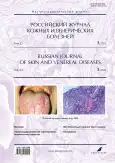Сравнительное исследование эффективности антивозрастного крема с гидрохиноном и широкополосного импульсного света при мелазме
- Авторы: Сидоренко О.А.1, Опруженкова Е.П.1, Аркатова Е.А.1
-
Учреждения:
- Ростовский государственный медицинский университет
- Выпуск: Том 25, № 3 (2022)
- Страницы: 219-227
- Раздел: ДЕРМАТОЛОГИЯ
- URL: https://journals.rcsi.science/1560-9588/article/view/108987
- DOI: https://doi.org/10.17816/dv108987
- ID: 108987
Цитировать
Аннотация
Обоснование. Мелазма ― один из самых распространённых видов гиперпигментации, значительно нарушающих качество жизни пациентов. Несмотря на наличие эффективных средств и методов терапии гиперпигментации, на сегодняшний день не существует чётких протоколов ведения пациентов с мелазмой.
Цель ― оценка клинической эффективности омолаживающего крема против пигментных пятен (2% гидрохинона и 0,025% третиноина) в составе комплексной терапии мелазмы у женщин.
Материал и методы. В статье представлены данные сравнительной оценки клинической эффективности антивозрастного крема (2% гидрохинона и 0,025% третиноина) в терапии мелазмы у женщин (n=30) в возрасте от 35 до 46 лет. Участники исследования были разделены на 3 группы: пациенты 1-й группы (n=10) получали наружную терапию омолаживающим кремом 1 раз в день на ночь в течение 3 мес, пациенты 2-й группы (n=10) ― фототерапию аппаратом Lumenis M22 модуль Universal IPL 1 раз/мес в течение 3 мес, в 3-й группе (n=10) ― комбинированную терапию (омолаживающий крем + фототерапия аппаратом Lumenis M22 модуль Universal IPL) 1 раз/мес в течение 3 мес. До начала терапии всем пациентам определялась степень тяжести мелазмы на основании расчёта индексов MASI (Melasma Area and Severity Index) и MSS (Melasma Severity Scale); проводились также измерения уровня меланина в коже методом мексаметрии и оценка влияния мелазмы на качество жизни с помощью опросника MELASQoL. Оценка эффективности терапии проводилась с учётом динамики индекса MASI и параметров мексаметрии до лечения и через 29 дней терапии. Сравнение показателей MELASQoL осуществляли до лечения, через 29 дней терапии и спустя 3 мес.
Результаты. Максимально выраженная клиническая эффективность (снижение степени тяжести мелазмы, уменьшение количества меланина в коже и улучшение качества жизни) наблюдалась в 3-й группе пациенток, получавших комбинированное лечение антивозрастным кремом на основе гидрохинона и фототерапию аппаратом Lumenis M22 модуль Universal IPL 1 раз/мес в течение 3 мес. У пациентов 1-й группы, получавших только наружную терапию омолаживающим кремом, отмечалось достоверное снижение уровня меланина в коже и улучшение качества жизни через 29 дней терапии и спустя 3 мес.
Заключение. Комбинация омолаживающего крема на основе гидрохинона с широкополосным импульсным светом является эффективным методом коррекции мелазмы.
Полный текст
Открыть статью на сайте журналаОб авторах
Ольга Анатольевна Сидоренко
Ростовский государственный медицинский университет
Email: ola_ps@mail.ru
ORCID iD: 0000-0002-7387-2497
SPIN-код: 2209-0521
д.м.н., профессор
Россия, Ростов-на-ДонуЕвгения Павловна Опруженкова
Ростовский государственный медицинский университет
Автор, ответственный за переписку.
Email: eva_derm@mail.ru
ORCID iD: 0000-0002-5830-1768
SPIN-код: 6516-3262
к.м.н., доцент
Россия, Ростов-на-ДонуЕкатерина Анатольевна Аркатова
Ростовский государственный медицинский университет
Email: arcatova@gmail.com
ORCID iD: 0000-0001-6966-4153
SPIN-код: 7478-5709
ассистент
Россия, Ростов-на-ДонуСписок литературы
- Кричигина Т.Н., Грушин В.Н., Беликова И.С., и др. Меланоциты: строение, функции, методы выявления, роль в кожной патологии // Вестник ВГМУ. 2007. Т. 6, № 4. С. 5–16.
- Голдсмит Л.А., Кац С.И., Джилкрест Б.А. Дерматология Фитцпатрика в клинической практике: в 3 т. / под ред. Н.Н. Потекаева, А.Н. Львова. Т. 1. Москва: Издательство Панфилова, 2015. С. 849–915.
- Олисова О.Ю., Андреева Е.В. Еще раз о проблеме гиперпигментации // Российский журнал кожных и венерических болезней. 2014. № 2. С. 20–24.
- Круглова Л.С., Иконникова Е.В. Гиперпигментация кожи: современные взгляды на этиологию и патогенез (часть 1) // Российский журнал кожных и венерических болезней. 2017. Т. 20, № 3. С. 178–183. doi: 10.18821/1560-9588-2017-20-3-178-183
- Kwon S.H., Hwang Y.J., Lee S.K., Park K.C. Heterogeneous pathology of melasma and its clinical implications // Int J Mol Sci. 2016. Vol. 17, N 6. Р. piiE824. doi: 10.3390/ijms17060824
- Круглова Л.С., Иконникова Е.В. Гиперпигментация кожи: современный взгляд на методы коррекции (часть 2) // Российский журнал кожных и венерических болезней. 2017. Т. 20, № 4. С. 248–251. doi: 10.18821/1560-9588-2017-20-4-248-251
- Шаруханова А.А. Клинико-лабораторное обоснование дифференцированной терапии мелазмы у женщин: Автореф. дис. … канд. мед. наук. Москва, 2019. 29 с.
- Хегер П.Г. Детская дерматология / пер. с нем. под ред. А.А. Кубановой, А.Н. Львова. Москва: БИНОМ, 2013. С. 452–476.
- Vashi N.A., Kundu R.V. Facial hyperpigmentation: causes and treatment // Br J Dermatol. 2013. Vol. 169, N 3. Р. 41–56. doi: 10.1111/bjd.12536
- Курадовец А.А. Разработка и валидация русскоязычной версии опросника MELASQoL-РУС для косметологической практики // Здоровье и образование в XXI веке. 2018. Т. 20, № 4. С. 79–83. doi: 10.26787/nydha-2226-7425-2018-20-4
Дополнительные файлы











